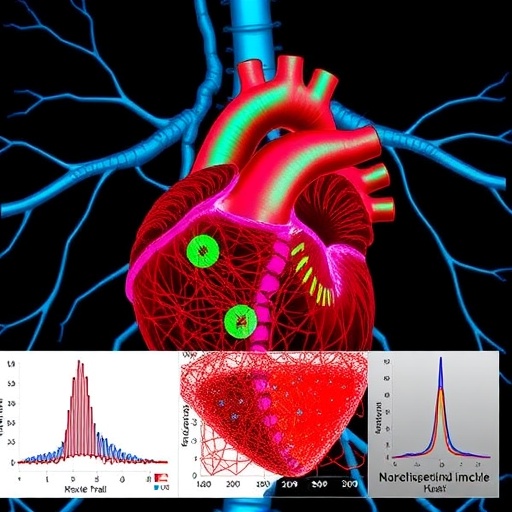In the relentless battle against sepsis, a condition responsible for millions of deaths annually worldwide, clinicians and researchers have long sought therapeutic strategies to mitigate its devastating impact. A groundbreaking study published recently in Nature Communications offers a transformative approach to understanding the efficacy of corticosteroids in sepsis management by integrating data across multiple centers and employing state-of-the-art predictive modeling of organ dysfunction trajectories. By emulating a target trial within a multicenter observational dataset, the research team led by Rajendran, Xu, Pan, and colleagues, addresses the complex heterogeneity of sepsis, opening new avenues for precision medicine in critical care.
Sepsis unfolds as a multifaceted syndrome characterized by a dysregulated host response to infection, culminating in life-threatening organ dysfunction. The clinical presentation and progression vary substantially among patients, making uniform therapeutic protocols challenging. Corticosteroids, potent immunomodulatory agents, have been the subject of intense investigation for decades due to their potential to suppress excessive inflammation and restore hemodynamic stability. However, divergent trial outcomes have fueled controversy regarding their routine use. The novel methodology adopted in this study transcends traditional randomized controlled trial (RCT) frameworks by simulating a target trial within real-world data, accounting for patient-specific organ failure trajectories that may predict differential responses.
Harnessing multicenter data not only amplifies statistical power but also captures a diversity of clinical settings and patient populations, enhancing the generalizability of findings. The investigators meticulously curated datasets encompassing longitudinal clinical measurements, laboratory values, and therapeutic interventions from hospitals spanning different geographical regions. This comprehensive data integration was pivotal in constructing dynamic models to forecast organ dysfunction evolution, employing advanced machine learning algorithms that distilled intricate patterns otherwise invisible to clinicians. The resultant stratification of patients based on predicted organ dysfunction trajectories enabled a nuanced evaluation of corticosteroid efficacy tailored to individual disease courses.
Central to the study’s innovation is the emulation of a “target trial” — a conceptual RCT framework designed to rigorously evaluate causal effects from observational data by explicitly defining eligibility criteria, treatment strategies, and follow-up protocols. By reconstructing these elements retrospectively, the researchers circumvented common biases inherent in observational research, such as confounding and selection bias. This methodological rigor ensured that comparisons between corticosteroid-treated and untreated groups were robust, permitting reliable inference about treatment benefits or harms across distinct patient subgroups stratified by their predicted organ failure pathways.
The insights acquired reveal that corticosteroids confer varying degrees of mortality benefit contingent on the temporal trajectory and severity of organ dysfunction. Patients predicted to experience rapidly escalating respiratory failure, for instance, showed pronounced improvement when administered corticosteroids early, highlighting a window of therapeutic opportunity previously obscured in averaged trial data. Conversely, subsets with stable or slowly progressive organ impairment did not exhibit significant benefits, underscoring the potential risks of indiscriminate steroid use. This stratified therapeutic response underscores the imperative for tailoring interventions not solely based on static clinical parameters but on dynamic physiological progressions.
Technically, the study leveraged recurrent neural networks (RNNs) and hidden Markov models (HMMs) to delineate the temporal evolution of variables such as oxygenation indices, vasopressor requirements, and renal function markers. These computational tools synthesize temporal dependencies and latent states critical in sepsis pathophysiology, thereby enabling real-time risk stratification. The interpretability of these models was further enhanced by integrating clinical expertise to cross-validate predictive outputs with known pathobiological mechanisms, ensuring that the algorithms’ decisions aligned with physiologic plausibility rather than statistical artifact.
Moreover, the collaborative effort underscored the importance of harmonizing electronic health record (EHR) data across institutions, highlighting challenges such as standardization of laboratory assays, vital sign documentation, and coding practices. Addressing these disparities required sophisticated data preprocessing pipelines and harmonization frameworks, which the authors detail extensively. Their approach sets a precedent for future multicenter observational studies seeking to leverage the ever-expanding reservoirs of clinical data for therapeutic evaluation without the constraints of traditional RCTs.
The implications of this research extend beyond the immediate context of sepsis and corticosteroids. It exemplifies an emerging paradigm in clinical epidemiology where large-scale, high-dimensional observational data coupled with robust causal inference methods can supplant or augment conventional trials, particularly in conditions marked by heterogeneity and rapid clinical fluctuations. The capacity to dynamically stratify patients and tailor therapeutic interventions holds promise for enhancing outcomes not only in critical care but across a spectrum of acute and chronic diseases.
Importantly, the study also examines safety endpoints, revealing that corticosteroid administration in certain trajectory-based subgroups may predispose patients to secondary infections or hyperglycemia, emphasizing the necessity of vigilant monitoring and risk-benefit assessment. This balanced perspective provides clinicians with actionable insights grounded in multidimensional risk profiles rather than simplistic treatment algorithms, advancing personalized medicine’s realistic implementation.
The use of target trial emulation represents a sophisticated fusion of epidemiological principles and data science, ensuring that causal claims withstand the scrutiny of methodological rigor. By explicitly specifying the time-varying nature of exposures and confounders, the authors adeptly navigate potential biases such as immortal time bias and confounding by indication, common pitfalls in observational studies of critically ill populations. This analytical precision bolsters confidence in the observed associations and supports their translation into clinical guidelines.
From a broader perspective, the study’s findings necessitate reconsideration of clinical practice guidelines that currently advocate a one-size-fits-all approach for corticosteroid use in sepsis. Incorporation of predictive analytics to inform the timing and selection of therapy aligns with a precision health framework, optimizing therapeutic efficacy while minimizing harm. This dynamic modeling approach could also be adapted to evaluate other pharmacologic agents or supportive measures in the intensive care unit context.
The research team’s transparent sharing of code and data processing pipelines enhances reproducibility and invites independent validation, a critical component for establishing trust in machine learning applications within healthcare. Their rigorous external validation across diverse hospital systems affirms the robustness of their models and reinforces the general applicability of their conclusions. Such openness fosters a collaborative ethos vital for accelerating scientific progress in this domain.
Future research directions prompted by this study include prospective clinical trials designed with trajectory-based stratification embedded from inception, enabling direct testing of the hypotheses generated. Additionally, integration of biomarker profiles and genomic data with clinical trajectories could refine predictions further, revealing mechanistic underpinnings of differential treatment responses. Such multimodal approaches promise to unravel the biological complexity of sepsis and revolutionize therapeutic paradigms.
In conclusion, this pioneering work by Rajendran and colleagues signifies a major advance in sepsis research, illustrating how cutting-edge data science, combined with rigorous causal inference frameworks, can elucidate nuanced treatment effects within highly variable clinical syndromes. Their innovative use of multicenter target trial emulation stratified by predicted organ dysfunction trajectories marks a shift towards tailored therapeutics, offering hope for improved survival and reduced morbidity in one of medicine’s most challenging frontiers.
Subject of Research: Evaluation of corticosteroid efficacy in sepsis treatment stratified by predicted organ dysfunction trajectories using multicenter target trial emulation.
Article Title: Multicenter target trial emulation to evaluate corticosteroids for sepsis stratified by predicted organ dysfunction trajectory.
Article References: Rajendran, S., Xu, Z., Pan, W. et al. Multicenter target trial emulation to evaluate corticosteroids for sepsis stratified by predicted organ dysfunction trajectory. Nat Commun 16, 4450 (2025). https://doi.org/10.1038/s41467-025-59643-z
Image Credits: AI Generated
Tags: clinical approaches to sepsiscontroversies in corticosteroid useCorticosteroids in sepsis treatmentevaluating corticosteroid efficacyheterogeneity of sepsis responsesimmunomodulatory agents for infectionmulticenter observational study on sepsisorgan dysfunction trajectories in sepsisprecision medicine for sepsis managementpredictive modeling in critical carereal-world data in medical researchtarget trial emulation in medicine





